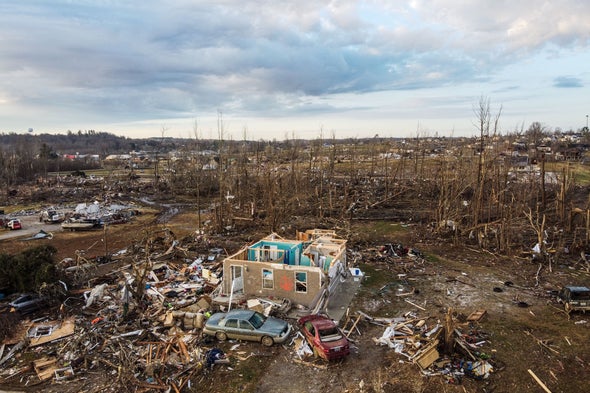How Long Can A Tornado Last
Quad-Country Tornado May Exist Longest-Lasting Ever
Why some tornadoes are able to travel so far and persist so long

The monster tornado that destroyed the town of Mayfield, Ky., during terminal weekend's mortiferous outbreak in the Midwest and Southeast may have traversed iv states without always lifting off the ground.
The National Weather Service (NWS) office in Paducah, Ky., confirmed to the Weather Channel this week that the "Quad-State Tornado" carved a continuous path of 128 miles through the office's region of responsibility (which covers southeastern Missouri, western Kentucky, southern Illinois and the southernmost tip of Indiana) last Friday. Offices with bordering jurisdictions are analyzing whether the tornado went on to cover a total of 250 miles across Arkansas, Missouri, Tennessee and Kentucky. If information technology did so, it would break a record assail March 18, 1925, when the Tri-Country Tornado ripped beyond 219 miles of Missouri, Illinois and Indiana.
From touchdown to dissipation, the Quad-Land Tornado may accept spent a stunning four hours on the footing. Most tornadoes survive for no more than than 10 to 20 minutes, says John Allen, a meteorologist and climate scientist at Central Michigan University.
The recent twister was able to last and so long because a number of crucial ingredients came together. The recipe for such a record-billow starts with the right atmospheric weather condition to create a supercell thunderstorm, the strongest of all thunderstorm types. Temperatures more than characteristic of April than December—with highs around 80 degrees Fahrenheit—were a key gene, says Victor Gensini, an atmospheric scientist at Northern Illinois Academy. Allen agrees. "It [was] a very warm and muggy air mass," he says, "and those are very ripe conditions for strong, severe thunderstorms."
Supercell storms also crave current of air shear—winds blowing from different directions at different heights in the atmosphere—in order to form. There was plenty of air current shear on Friday, maybe owing in role to La Niña weather condition. Atmospheric patterns during a La Niña event set up the jet stream over Northward America in a way that leads to cool-season storms in the Southeast, Gensini says.
These factors fuel an engine of ascent and rotating air called a mesocyclone, which powers a supercell. Not all mesocyclones turn into tornadoes, notes Alexandra Anderson-Frey, an atmospheric scientist at the University of Washington. Only the vast majority of damaging tornadoes start as mesocyclones.
In these potentially tornado-spawning storms, the mesocyclone begins to extend toward the basis, narrowing as it does. The leading theory for why this happens, Anderson-Frey says, is that the storm releases a downward-moving blitz of precipitation-chilled air, which exerts a force that pulls the vortex toward the ground. Equally the resulting funnel cloud narrows, information technology begins to spin faster, much like a figure skater pulling in their arms to execute a tight rotation.
This detail tempest's strength and system enabled it to hang together for many hours, helped by the fact that that there were no other storm systems nearby, Anderson-Frey says. When storms collaborate, they can weaken one another, she explains. For example, the absurd downdraft of i tempest might spread into some other tempest's territory, robbing the second storm of warm, rise air that tin can power its growth. No such competition affected Fri night's tempest. "Those favorable conditions, that lack of interference by other storms, that all seems to have been maintained for a very long fourth dimension," Anderson-Frey says. This allowed for conditions that supported the long-lasting tornado. (Multiple other tornadoes also formed in the supercell, merely meteorologists are all the same trying to determine how many, and how long each lasted.)
Speed likewise played a role in how much basis the Quad-country Tornado was able to cover. The supercell that created information technology was moving forrad at effectually 55 miles per hour because of the "extreme amounts of vertical wind shear," Gensini says. Almost thunderstorms churn along at a far more sedate 5–10 mph, which limits their achieve. Long-rails tornadoes are especially dissentious because they have more than opportunities to striking buildings than shorter-lived twisters.
The death toll in Kentucky and surrounding states (currently 88) would likely have been even worse if people had not been tuned in to early warnings. "If you lot go back to the 1925 result, that killed 695 people," Gensini says. "We're not even close to that number of fatalities, and I think that speaks volumes to our ability to warn for, forecast and predict these kinds of events."
Source: https://www.scientificamerican.com/article/quad-state-tornado-may-be-longest-lasting-ever/
Posted by: williamswiteasteme.blogspot.com



0 Response to "How Long Can A Tornado Last"
Post a Comment